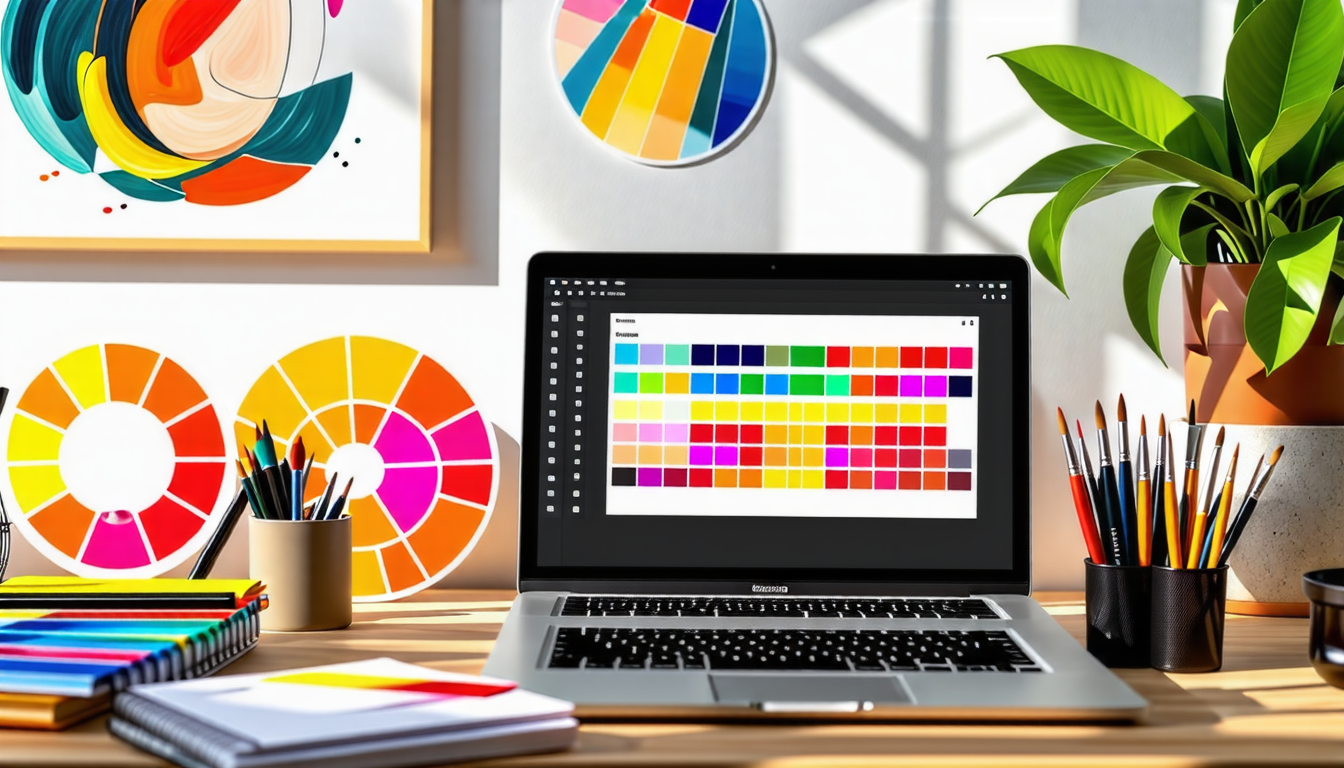|
IN BRIEF
|
Color is not just a simple visual aspect; it serves as the emotional backbone of your image design. The right color palette can dramatically transform a mundane concept into a captivating visual narrative. Imagine crafting a design that resonates perfectly with your target audience—this is where the magic of color selection comes into play. Whether you are curating a website, designing a logo, or working on a marketing campaign, understanding how to choose colors that reflect your brand identity and evoke the desired emotions is crucial. Dive into the fascinating world of hues, shades, and tones, and unlock the secrets to creating stunning, harmonious designs that not only look great but also leave a lasting impression.

Understanding Color Context
Understanding the context of the colors you choose for your image design is crucial. Colors do not exist in a vacuum; they evoke feelings, represent ideas, and convey messages. For instance, a vibrant red can signify passion and energy, while a calming blue often evokes a sense of tranquility. Consider the emotions and perceptions you wish to communicate through your design and choose colors that align with your vision.
Assess Your Concept and Theme
Before diving into color selection, reflect on your concept and the theme of your project. Whether you’re creating a website, branding materials, or a piece of art, understanding your project’s purpose will greatly influence your color choices. Ask yourself: What mood do I want to convey? What message should these colors communicate? Having clarity on these aspects will guide your decision-making process.
Utilizing the Color Wheel
The color wheel is a powerful tool in the designer’s arsenal. It provides a visual representation of how colors relate to one another.
Complementary Colors
To create contrast and draw attention, explore complementary color schemes. These are colors opposite each other on the color wheel, such as blue and orange. Utilizing these combinations can add excitement and vibrancy to your design.
Analogous Colors
In contrast, analogous colors lie next to each other on the wheel. These combinations, like blue, green, and teal, often create a soothing and harmonious appearance. This approach is perfect when aiming for a cohesive and calming design.
Triadic Color Schemes
Another method is to use a triadic color scheme, which involves selecting three colors that are evenly spaced around the color wheel. This technique offers a vibrant palette, balancing each color and providing plenty of visual interest.
Emphasizing a Core Color
While it may be tempting to explore many colors, focusing on a single core color can streamline your design and enhance its effectiveness. This color should be representative of your brand or the emotion you wish to convey.
Building Around Your Core Color
Once you have identified your core color, use it as a base and build around it. Choose secondary colors that complement or contrast with your primary choice to enrich your design. This method creates a cohesive and unified appearance.
Tips for Core Color Selection
To select a core color, consider the psychological implications of different hues. For example, if your design is intended to invoke feelings of calmness and peace, soft blues or greens might be the ideal choice. Pay attention to trending colors as well; seasonal shifts can inspire color palettes that resonate well with current audiences.
Experimenting with Color Schemes
Explore different color combinations by trying multiple color schemes. Don’t hesitate to experiment, as trial and error often lead to unexpected and innovative results.
Digital Tools for Color Selection
There are many online tools available, such as Coolors or Pixelied, that can assist in generating harmonious color combinations. These resources allow you to input your primary color and provide suggestions for complementary and analogous colors.
Creating Mood Boards
Another effective method is to create mood boards. Gather images, textures, and examples of color palettes that inspire you. This visual representation helps capture the essence of what you aim to achieve and can clarify your direction.
Establishing Proportions in Color Usage
Your color palette should have a clear hierarchy. Establishing proportions can ensure a balanced and effective design.
The 60-30-10 Rule
This classic interior design rule translates well into graphic design. The 60-30-10 rule suggests using 60% of your dominant color, 30% of a secondary color, and 10% for accent colors. This approach provides balance and ensures that no single color overwhelms the design.
Consider Accessibility
When choosing your colors, consider how your audience will perceive them. Ensure that your color choices are accessible for those with visual impairments. Use high contrast combinations for text and backgrounds, and avoid relying solely on color to convey information.
Staying Open to Exploration
Even after finalizing your color palette, remember that the journey of color selection is ongoing. Don’t become complacent; your design can evolve. Regularly seek inspiration from other designs, nature, and contemporary art.
Refreshing Your Palette
Over time, as trends and styles change, revisiting your color choices can invigorate your design work. It’s perfectly acceptable to refresh and update your color palette as you gain new insights and experiences.
Analyzing the Impact of Culture on Color Choices
Colors can have different meanings in various cultures. It’s essential to be aware of the cultural significance of colors when designing for an international audience.
Researching Cultural Associations
For instance, while white is often associated with purity in Western cultures, it can symbolize mourning in others. Understanding these cultural perceptions can help you avoid miscommunication and ensure that your design resonates with a global audience.
Finalizing Your Color Palette
After going through the selection process, it’s time to finalize your color palette. Take a step back and evaluate your choices to ensure they align with your project goals and effectively communicate your intended message.
Testing in Real-World Applications
Before fully committing to your palette, test it in real-world applications. Create mock-ups or prototypes using your selected colors to see how they interact with typography, images, and overall layout. Making adjustments at this stage can save time and effort in the long run.
Gathering Feedback
Lastly, seek feedback from peers, clients, or target audience members. Fresh perspectives can provide insights that you may have overlooked. Use this feedback constructively to make any necessary adjustments.
Choosing the right color palette for your image design is a vital step that can significantly influence the overall aesthetic and effectiveness of your work. To start, it’s essential to understand the context in which your colors will be used. Consider the feelings and associations your chosen colors evoke. For instance, blue often conveys tranquility, while red can evoke passion or excitement.
Utilizing a color wheel can greatly simplify the process. This tool helps identify complementary and analogous colors, leading to harmonious combinations. For example, a study has shown that designs using a balanced color palette can increase user engagement by up to 80%.
Moreover, focusing on a single dominant color while introducing secondary shades can create a strong visual hierarchy. Testing multiple schemes allows for the exploration of different combinations, ensuring that the final choice resonates with the intended audience.
Lastly, continuous exploration can yield surprising results. Color palettes can evolve based on current trends or emerging technologies, so staying informed is crucial. Regularly revisiting your color choices can lead to designs that not only look stunning but also engage and connect with viewers effectively.

Selecting the right color palette for your image design is an artistic journey that transcends mere aesthetics. Begin by understanding the context of your project—what emotions and messages do you want to convey? Utilize a color wheel as a guide to harmonize your choices, allowing you to draw connections between complementary and analogous hues. It’s beneficial to focus on a dominant color to establish a foundation, then explore various combinations. Experiment with different color schemes to see which resonates best with your target audience. Remember, the process is iterative, and exploration is key; don’t hesitate to seek inspiration and adapt your palette to ensure it effectively enhances your design’s narrative.
FAQ
What is the first step in selecting a color palette for my design?
R: Begin by identifying the concept, theme, and overall style of your project. This foundational understanding will guide your color choices.
How can I use a color wheel to aid my selection?
R: A color wheel can help you understand the relationships between colors. You can explore complementary, analogous, or triadic color schemes to create a harmonious palette.
Should I focus on one particular color?
R: Absolutely! Starting with a single dominant color that resonates with your brand or message allows you to build a coherent and engaging color palette around it.
What is the 60-30-10 rule in color selection?
R: This rule suggests using colors in a 60% (dominant), 30% (secondary), and 10% (accent) ratio. This balance creates visual interest while maintaining harmony throughout your design.
How can I experiment with different color schemes?
R: Don’t hesitate to try out multiple color schemes! Use tools or online color generation platforms to explore various combinations, ensuring they align with your design’s mood and intention.

